Abstract
The effect of sublethal gamma radiation on inbred mice chronically infected with scrub typhus rickettsiae was examined. Inbred mice which were inoculated with the Gilliam or Karp strain of Rickettsia tsutsugamushi by the subcutaneous route harbored the infection for at least 1 year. Irradiation of these animals at 12 or 52 weeks postinoculation with normally sublethal levels induced a significantly higher percentage of rickettsemic mice (recrudescence) than was seen in the unirradiated, similarly infected control animals. In addition, sublethal irradiation at 12 weeks induced a quantitative increase in total rickettsiae. Homologous antibody titers to the rickettsiae were examined for 5 weeks after irradiation to determine the role of the humoral response in radiation-induced recrudescence. Unirradiated, infected mice showed consistent titers of about 320 throughout the 5-week observation period, and the titer was not affected by exposure of up to 500 rads of gamma radiation. Drug dose-dependent radioprotection and modification of recrudescence was noted in infected, irradiated mice treated with the antiradiation compound S-2-(3-aminopropylamino)ethyl phosphorothioic acid. The results of this investigation supported the conclusion that the recrudescence of a chronic rickettsial infection in the appropriate host after immunological impairment due to gamma radiation can result in an acute, possibly lethal rickettsemia.
Full text
PDF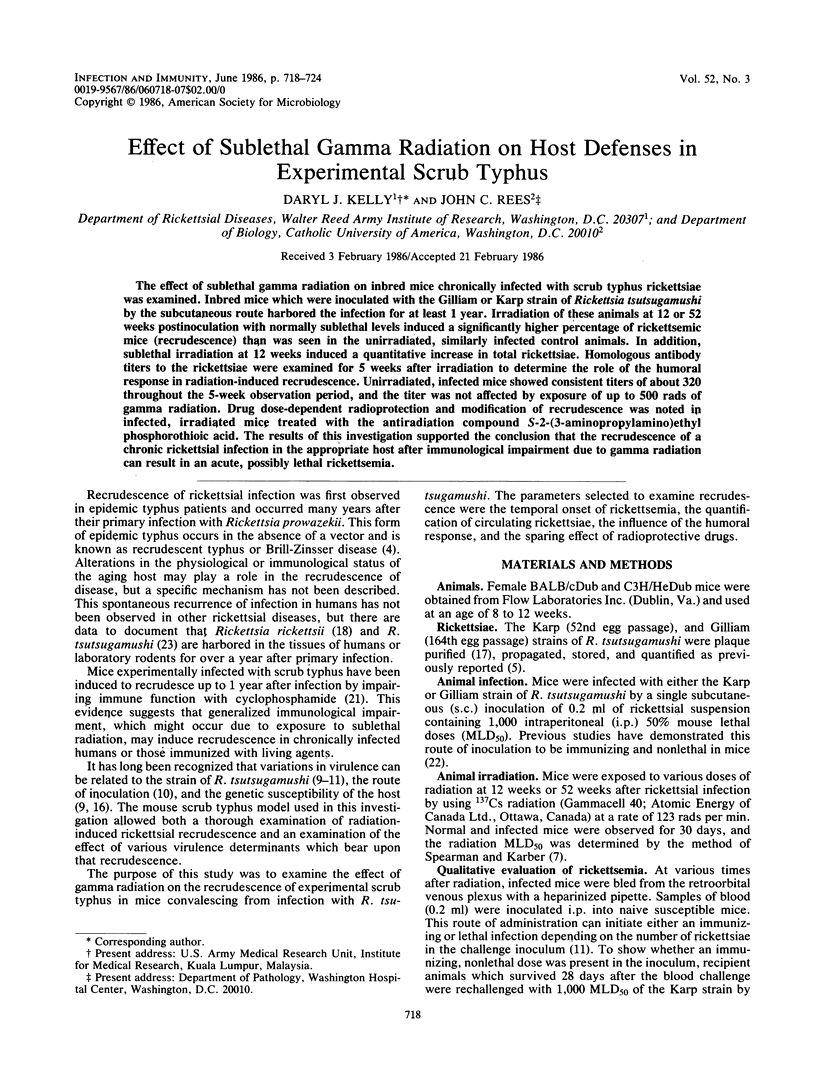
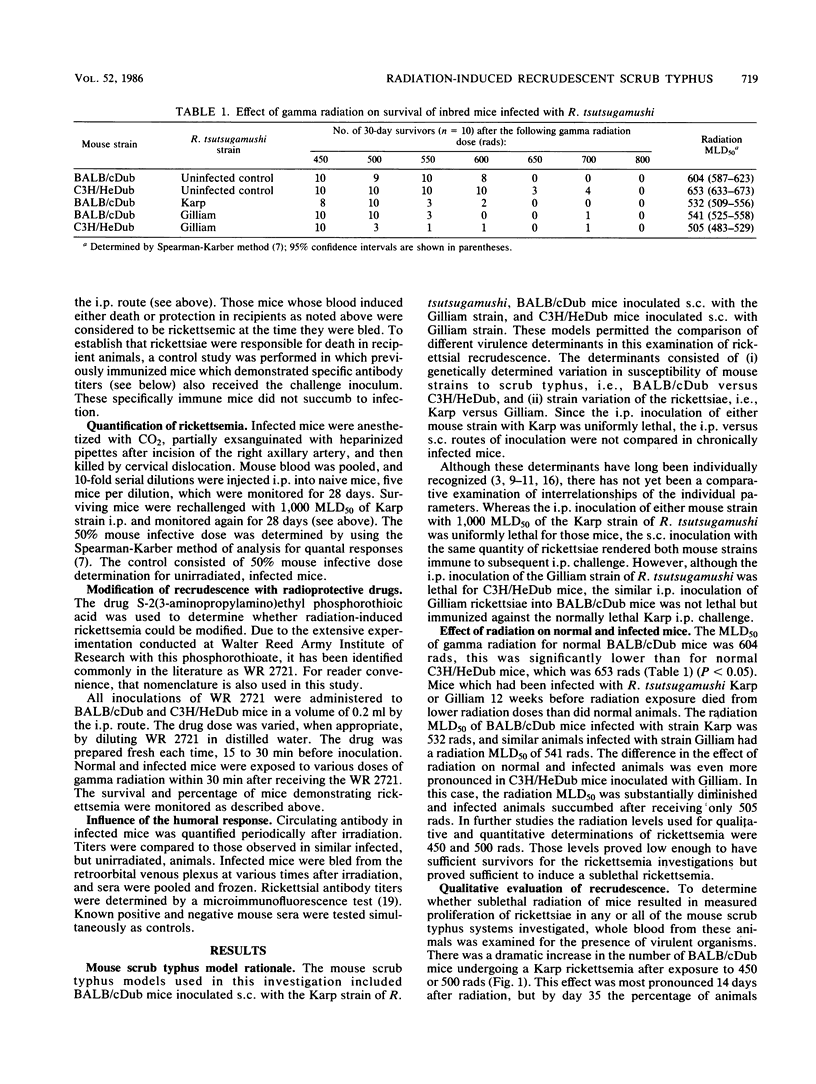


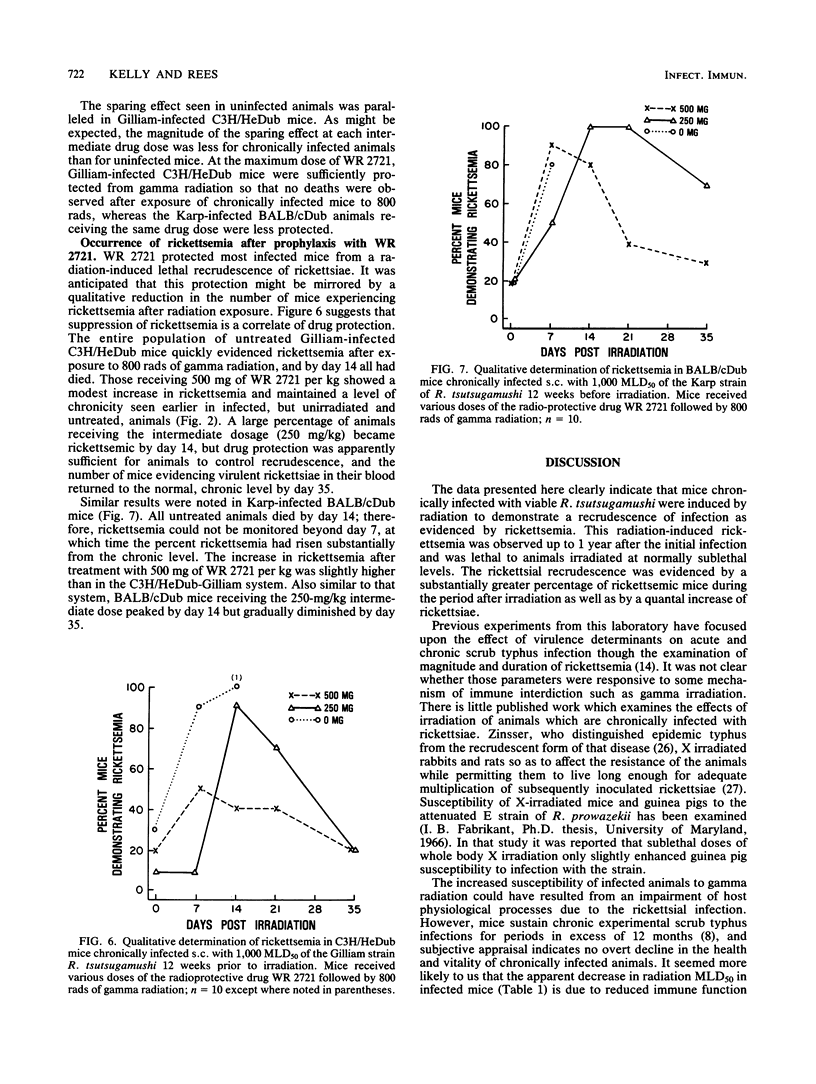
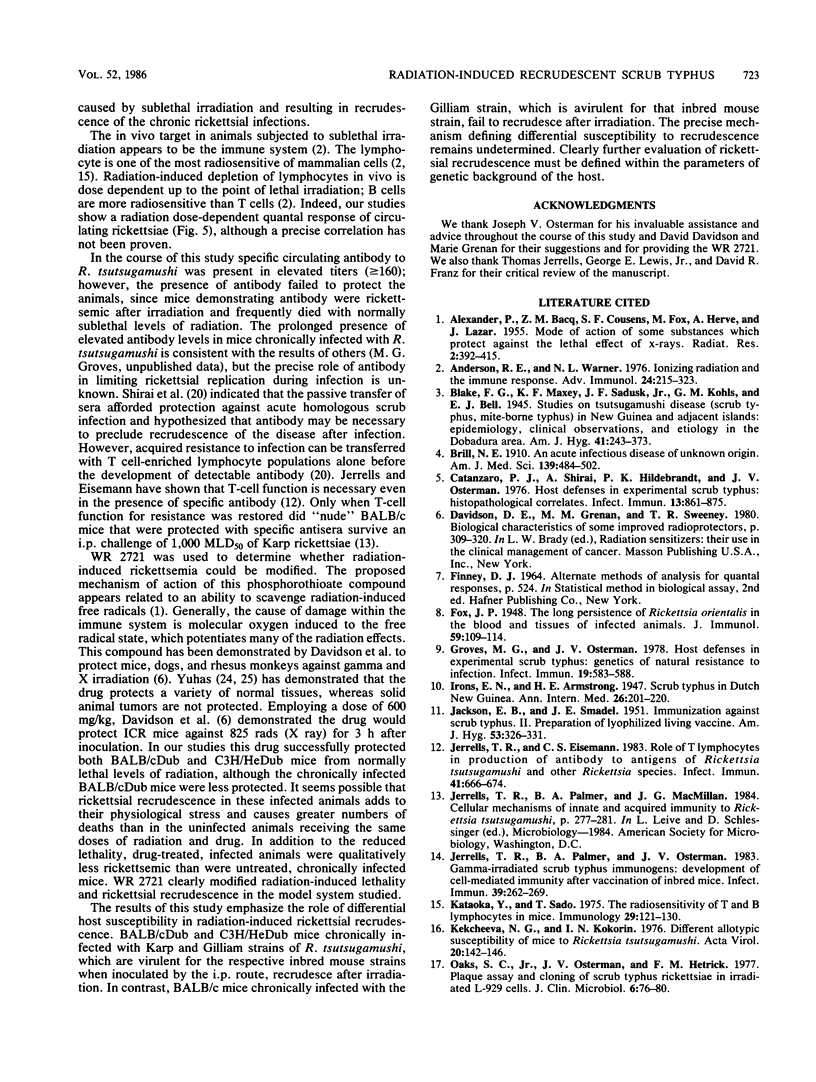
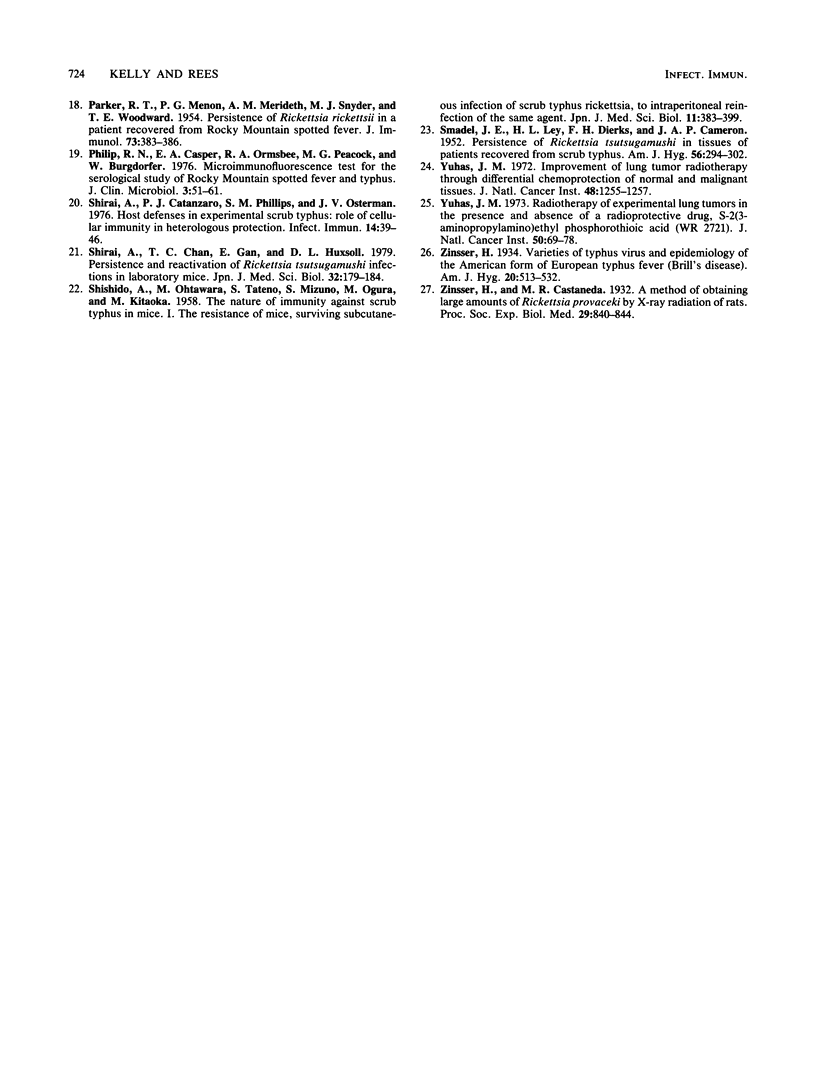
Selected References
These references are in PubMed. This may not be the complete list of references from this article.
- ALEXANDER P., BACQ Z. M., COUSENS S. F., FOX M., HERVE A., LAZAR J. Mode of action of some substances which protect against the lethal effects of x-rays. Radiat Res. 1955 Jun;2(4):392–415. [PubMed] [Google Scholar]
- Anderson R. E., Warner N. L. Ionizing radiation and the immune response. Adv Immunol. 1976;24:215–335. doi: 10.1016/s0065-2776(08)60331-4. [DOI] [PubMed] [Google Scholar]
- Catanzaro P. J., Shirai A., Hilderbrandt P. K., Osterman J. V. Host defenses in experimental scrub typhus: histopathological correlates. Infect Immun. 1976 Mar;13(3):861–875. doi: 10.1128/iai.13.3.861-875.1976. [DOI] [PMC free article] [PubMed] [Google Scholar]
- Groves M. G., Osterman J. V. Host defenses in experimental scrub typhus: genetics of natural resistance to infection. Infect Immun. 1978 Feb;19(2):583–588. doi: 10.1128/iai.19.2.583-588.1978. [DOI] [PMC free article] [PubMed] [Google Scholar]
- JACKSON E. B., SMADEL J. E. Immunization against scrub typhus. II. Preparation of lyophilized living vaccine. Am J Hyg. 1951 May;53(3):326–331. doi: 10.1093/oxfordjournals.aje.a119457. [DOI] [PubMed] [Google Scholar]
- Jerrells T. R., Eisemann C. S. Role of T-lymphocytes in production of antibody to antigens of Rickettsia tsutsugamushi and other Rickettsia species. Infect Immun. 1983 Aug;41(2):666–674. doi: 10.1128/iai.41.2.666-674.1983. [DOI] [PMC free article] [PubMed] [Google Scholar]
- Jerrells T. R., Palmer B. A., Osterman J. V. Gamma-irradiated scrub typhus immunogens: development of cell-mediated immunity after vaccination of inbred mice. Infect Immun. 1983 Jan;39(1):262–269. doi: 10.1128/iai.39.1.262-269.1983. [DOI] [PMC free article] [PubMed] [Google Scholar]
- Kataoka Y., Sado T. The radiosensitivity of T and B lymphocytes in mice. Immunology. 1975 Jul;29(1):121–130. [PMC free article] [PubMed] [Google Scholar]
- Kekcheeva N. G., Kokorin I. N. Different allotypic susceptibility of mice to Rickett-sia tsutsugamushi. Acta Virol. 1976 Apr;20(2):142–146. [PubMed] [Google Scholar]
- Oaks S. C., Jr, Osterman J. V., Hetrick F. M. Plaque assay and cloning of scrub typhus rickettsiae in irradiated L-929 cells. J Clin Microbiol. 1977 Jul;6(1):76–80. doi: 10.1128/jcm.6.1.76-80.1977. [DOI] [PMC free article] [PubMed] [Google Scholar]
- PARKER R. T., MENON P. G., MERIDETH A. M., SNYDER M. J., WOODWARD T. E. Persistence of Rickettsia rickettsii in a patient recovered from Rocky Mountain spotted fever. J Immunol. 1954 Dec;73(6):383–386. [PubMed] [Google Scholar]
- Philip R. N., Casper E. A., Ormsbee R. A., Peacock M. G., Burgdorfer W. Microimmunofluorescence test for the serological study of rocky mountain spotted fever and typhus. J Clin Microbiol. 1976 Jan;3(1):51–61. doi: 10.1128/jcm.3.1.51-61.1976. [DOI] [PMC free article] [PubMed] [Google Scholar]
- SMADEL J. E., LEY H. L., Jr, DIERCKS R. H., CAMERON J. A. P. Persistence of Rickettsia tsutsugamushi in tissues of patients recovered from scrub typhus. Am J Hyg. 1952 Nov;56(3):294–302. doi: 10.1093/oxfordjournals.aje.a119553. [DOI] [PubMed] [Google Scholar]
- Shirai A., Catanzaro P. J., Phillips S. M., Osterman J. V. Host defenses in experimental scrub typhus: role of cellular immunity in heterologous protection. Infect Immun. 1976 Jul;14(1):39–46. doi: 10.1128/iai.14.1.39-46.1976. [DOI] [PMC free article] [PubMed] [Google Scholar]
- Shirai A., Chan T. C., Gan E., Huxsoll D. L. Persistence and reactivation of Rickettsia tsutsugamushi infections in laboratory mice. Jpn J Med Sci Biol. 1979 Jun;32(3):179–184. doi: 10.7883/yoken1952.32.179. [DOI] [PubMed] [Google Scholar]
- Yuhas J. M. Improvement of lung tumor radiotherapy through differential chemoprotection of normal and tumor tissue. J Natl Cancer Inst. 1972 Apr;48(4):1255–1257. [PubMed] [Google Scholar]
- Yuhas J. M. Radiotherapy of experimental lung tumors in the presence and absence of a radioprotective drug, S-2-(3-aminopropylamino)ethylphosphorothioic acid (WR-2721). J Natl Cancer Inst. 1973 Jan;50(1):69–78. doi: 10.1093/jnci/50.1.69. [DOI] [PubMed] [Google Scholar]


